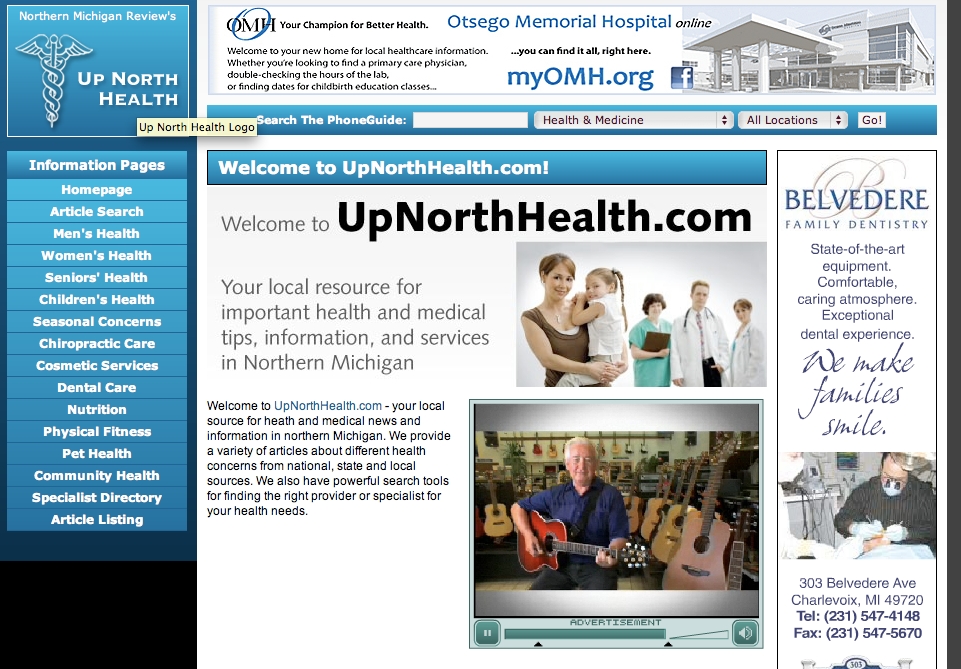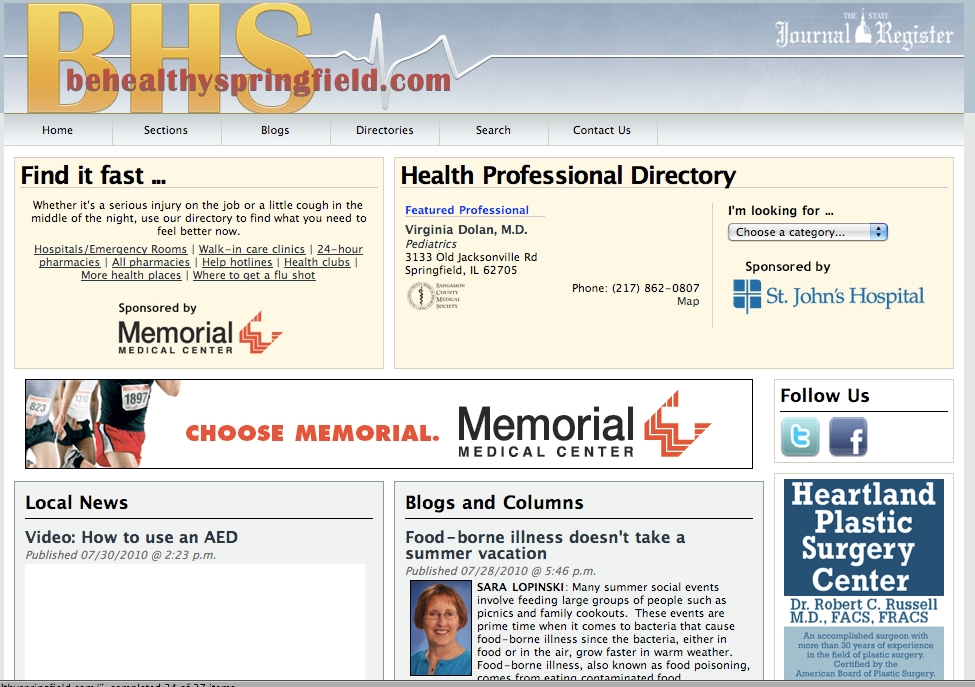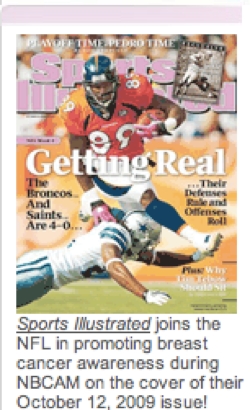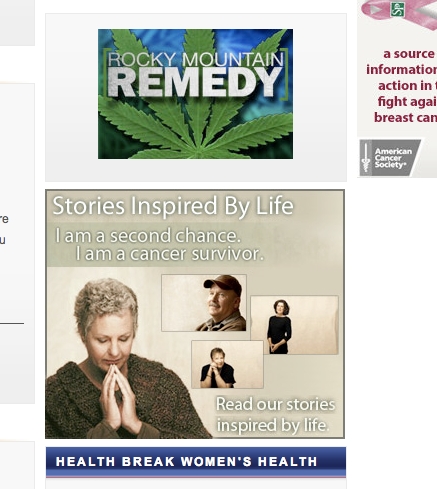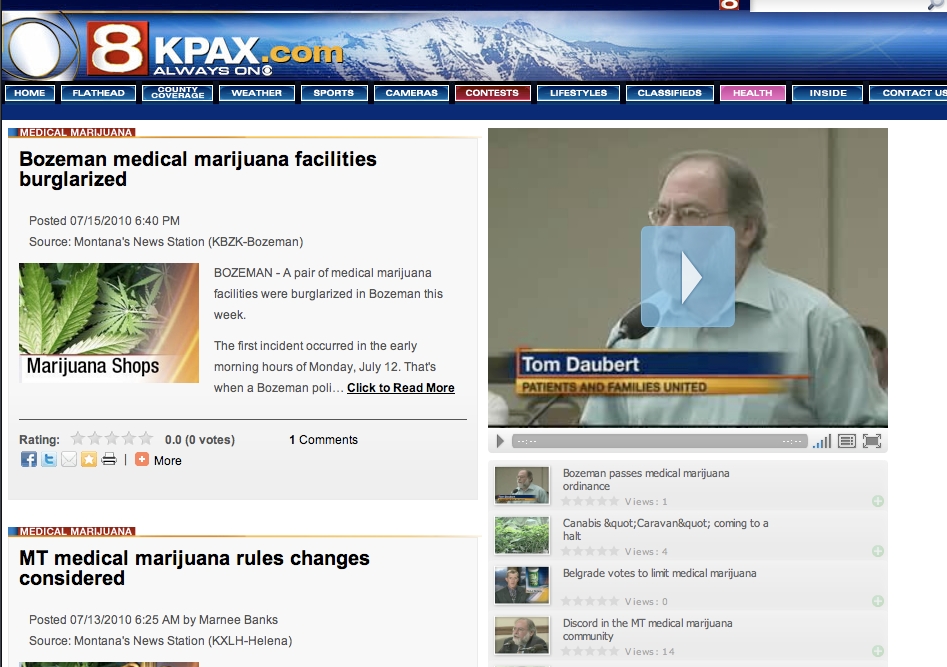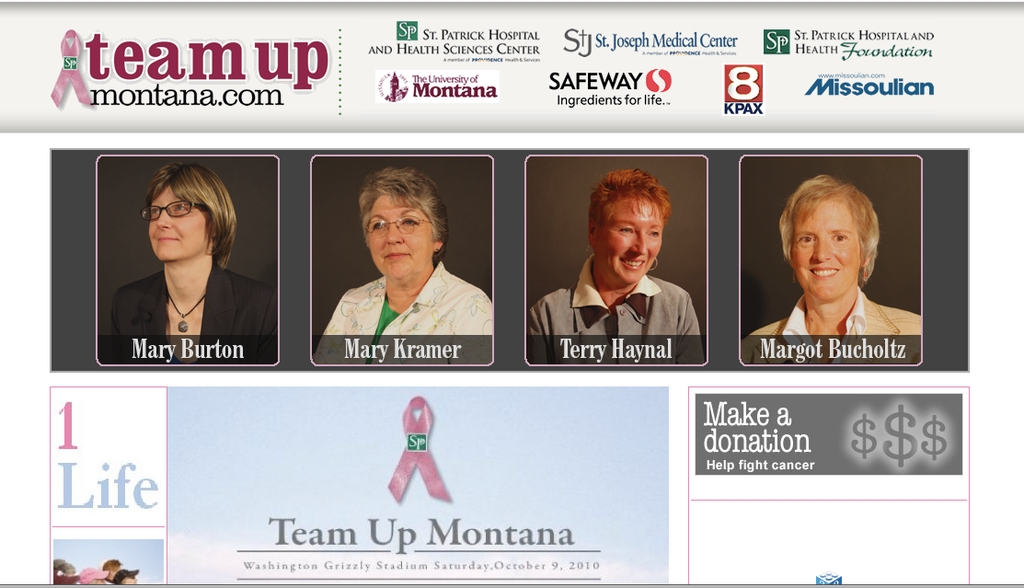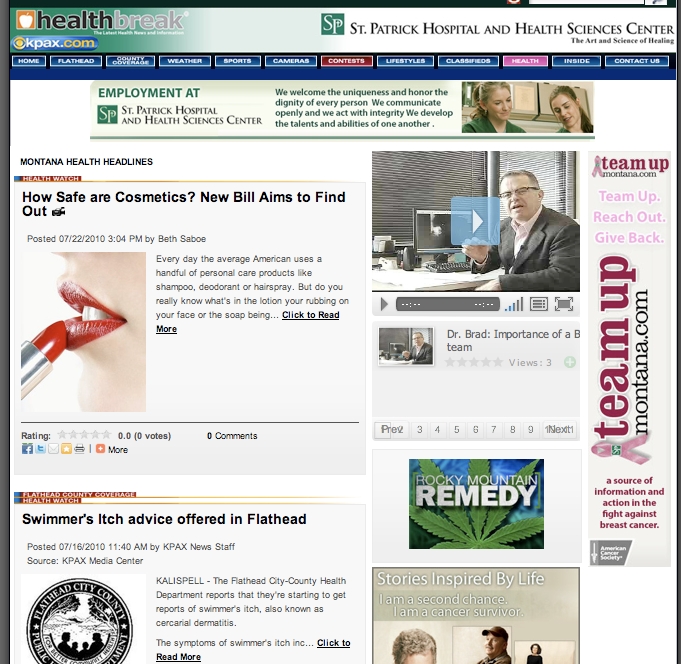Three health care niche sites that generate $15,000 to $85,000
One of the more lucrative categories in the local marketplace is healthcare services which have remained relatively stable throughout the recession and typically buy locally. One approach that several local media companies have taken is the development of health-related niche Web sites and channels. How much money do these sites make and what are the advantages versus simply running a campaign or contest? Here are three examples, all of them profitable, in different markets using different strategies.
1.Healthbreak
Site: KPAX.com CBS affliate in Missoula, Montana
Owner: Evening Post Publishing Company
Key executive: Philip Maney, director of Montana Interactive Division
Background: Since KPAX online director Philip Maney arrived at the station in 2007, site traffic has increased from around 2,500 UV's a month to more than 65,000 UV's, making it the top TV site among roughly 25 or so TV sites in the state. In addition, Maney says he is starting to see a unique audience of "news junkies" that exclusively follow the site, which gets breaking news posts all day before the stories are edited for broadcast in the afternoon. Still, the site has only about one tenth the traffic of the local newspaper site. One competitive advantage is a willingness to deploy new vertical content. To facilitate the ability to create and manage online channels and niche sites the company converted its platform from WorldNow to Synapse in early 2010.
Challenge: Since one key advertising sector is health services, KPAX.com stays close to the two largest providers, including St. Patrick Hospital in Missoula, Montana. A new marketing director at the hospital provided a new opportunity; she indicated an interest in creating unique online content, and strategies that would exclusive from the other hospital in the area. What could KPAX provide that would serve these needs?
Strategy: Maney's team integrated the hospital's marketing needs into the development of HealthBreak, a health news channel that could house a number of editorial and promotional initiatives, including inhouse content produced by the hospital and charitable promotions in partnership with other media groups. Major funding from the hospital would make the channel profitable from day one. Components of the partnership (see the five images on the right) include:
• Branding. The channel, "Health Break" is named after hospital-produced Q&A videos with doctors on the staff. The HealthBreak interviews are posted online in the new channel every Tuesday.
• Content. All the news stories have a video component. The core content for the channel is two to four video news clips a day supplied by HealthDayTV, a division of Newspronet. These are interspersed with clips from KPAX-TV's on-air health segments, including some interviews with St. Patrick's doctors on key topics such as cancer prevention. Other segments include Women's Health and "Rocky Mountain Remedy," devoted to medical marijuana news (the site does not accept ads for medical marijuana).
• "Inspired by Life," another hospital promotion, links to an area on the hospital's site with stories from cancer survivors.
• Great minds pink alike. Part of the sponsorship of the channel is an initiative to promote Breast Cancer Awareness Month. Maney registered "TeamUpMontana.com" and got together with the local newspaper (where he used to work) and the Montana Grizzlies college team (the main sports team in the state), to promote cancer awareness. The media companies matched paid ads with free spots, including dynamic online banners that encourage people to wear pink shirts to the football games. With Maney's help, a TeamUpMontana Facebook page launched this year and acquired 772 fans virally in the last three months. See an outline of the full campaign here.
Results: St. Patricks now spends about $40,000 to sponsor the channel and other online initiatives annually with KPAX, making one of the largest online advertisers in the state.
Lessons learned:
• Being able to creatively integrate the needs of large advertisers into content areas of sites is a key not only to growing major accounts but to supporting better, more expensive content for channels like health news.
• TV sites that incorporate premium video content and integrate other major account objectives may secure more dollars ahead of newspaper sites with much larger traffic and more advertisers on the channel/site. The key for HealthBreak was building elements the site around the advertiser's unique content, ather than selling only pre-created products and positions.
• Video is powerful and HealthNewsTV is a great option for sites exploring developing health news that updates several times a day.
• One drawback approach may be exclusivity element which limits total dollars from the category to one client.
2. Upnorthhealth.com
Market: Three cities in northern Michigan: Petosky,Charlotte,and Gaylord, average population 10,000
Traffic: 5,000 UV's and 20,000 page views
Launch date: Fall of 2008
Creator: Petoskeynews.com, owned by Schurtz Communications
Key executive: Jeff Johnson, Online manager
Challenge: A very small newspaper site PetoskeyNews.com wanted to take advantage of the thriving market for health care in Northern Michigan. Petoskeynews.com serves a population of just 7,000 so online manager Johnson decided to take on the challenge of creating a site that would cover healthcare for both Petosky and two nearby markets also owned by Schurtz Communications.
Strategy: Since budget was an issue, the site was built inhouse with no vendor costs. Johnson created the medical directory using a search box that accesses the existing IYP directory. News is provided by AP feed and from local advertiser press releases; each advertiser are allowed to submit two articles a month.
Results: The site has been popular with advertisers; 25 to 30 accounts are now running, including about 15 specifically sold to the site. Revenues total $15,000 to $20,000 in site specific revenues a year, and with no overhead this a profitable number.
Lessons learned: The health site is profitable and low resource way to attract health services advertisers, traffic has been an issue. The group is in the process of moving the site back inside the main newspaper site as a channel.
3. BeHealthySpringfield.com
Owner: Springfield State Journal-Register, sj-r.com, a Gatehouse publication
Launch date: September, 2009
Monthly Visitors: 20,000 to 25,000
Monthly Pageviews: 40,000
Key executive: Gary Tyler, Advertising Director
Challenge: Like many other local media, Springfield State Journal-Register wanted to tap into the healthcare market. To build a credible site quickly, they teamed up with the state medical association.
Strategy: The association co-branded with the site and supplied a database of its doctors, which Tyler's team improved and expanded to include about 10% more doctors outside the association.
Two directories, one for physicians and one for health services, are promoted in key positions at the top of the home page of the site and are responsible for most of the traffic. The site has sold logo-base sponsorships on directory search boxes. News for the site comes from the daily newspaper.
Results: Tyler thinks the partnership with the association gave the project instant viability for readers and advertisers. Seven or eight steady new advertisers run on annual contracts, and another 4 to 5 advertisers vary from month to month. Mainstay advertisers include hospitals, a plastic surgeon, a local clinic with 100 doctors and a chiropractic office. Tyler says the main hospital may have "bought anyway" but that the site still produces substantial incremental revenues, expected to be $60,000 to $85,000 for the first year with almost no extra costs - making it the most profitable of these three case studies.
Lessons learned: Tyler says incremental dollars are "well-worth it," though not as much as expected. Engagement is low, since most of the traffic is search-related, but advertisers on the site are doing well.
Conclusion: Even modest effort to compile health news attracts health care advertisers; the targeted audience makes these sites easy to profitably monetize with minimal resources. But healthcare service companies are no longer a safe source of institutional dollars, they are competitive and demand more and better internet strategies, so build in some flexibility to incorporate their needs. Ask about opportunities to promote for pet foundations and causes. The hospital site is a good place to look to gage current marketing initiatives, use of video and so on. HealthDayTV is also worth exploring as a option to create premium content that is updated several times a day, although you may want to find a large sponsor first. A niche site may not even be neccesary when a broader-based campaign or contest can meet hospital objectives. Here are two top ad campaigns for hospitals that don't rely on niche sites - one is a contest. So do the homework first: Survey needs and objectives of major advertisers in the local market - in detail! That is the most important element of creating a strategy to tap into these dollars.
One last note: The trade-off between higher dollars and having an exclusive presence should not be made lightly. Some niche sites have started off with an exclusive sponsor, and then shifted to category exclusivity as the site grew more solid. Cosmetic surgeons, chiropractors and weight loss clinics have solid click through rates and high ROI, making them ideal candidates for long term campaigns.

The author, Alisa Cromer is publisher of a variety of online media, including LocalMediaInsider and MediaExecsTech, developed while on a fellowship with the Reynolds Journalism Institute and which has evolved into a leading marketing company for media technology start-ups. In 2017 she founded Worldstir.com, an online magazine, to showcases perspectives from around the world on new topic each month, translated from and to the top five languages in the world.

